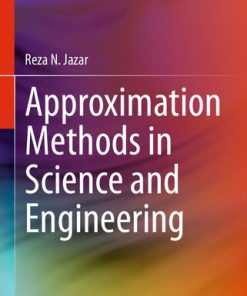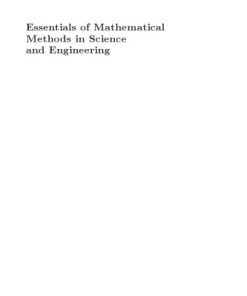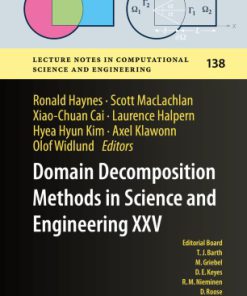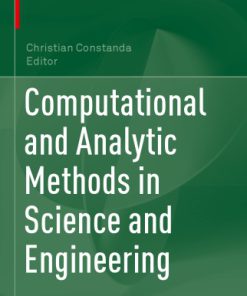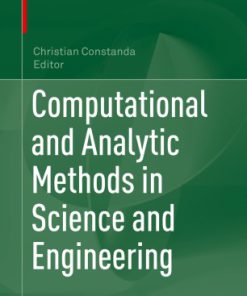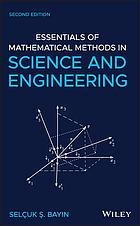Domain Decomposition Methods in Science and Engineering XXIII 1st Edition by Chang Ock Lee,Xiao Chuan Cai,David Keyes 3319523899 9783319523897
$50.00 Original price was: $50.00.$25.00Current price is: $25.00.
Domain Decomposition Methods in Science and Engineering XXIII 1st Edition by Chang Ock Lee,Xiao Chuan Cai,David Keyes – Ebook PDF Instant Download/Delivery:9783319523897,3319523899
Full download Domain Decomposition Methods in Science and Engineering XXIII 1st Edition after payment
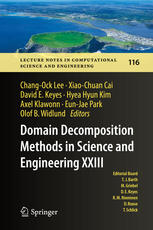
Product details:
ISBN 10:3319523899
ISBN 13:9783319523897
Author:Chang Ock Lee,Xiao Chuan Cai,David Keyes
This book is a collection of papers presented at the 23rd International Conference on Domain Decomposition Methods in Science and Engineering, held on Jeju Island, Korea on July 6-10, 2015. Domain decomposition methods solve boundary value problems by splitting them into smaller boundary value problems on subdomains and iterating to coordinate the solution between adjacent subdomains. Domain decomposition methods have considerable potential for a parallelization of the finite element methods, and serve a basis for distributed, parallel computations.
Domain Decomposition Methods in Science and Engineering XXIII 1st Table of contents:
Part I Plenary Talks (PT)
Global Convergence Rates of Some Multilevel Methods for Variational and Quasi-Variational Inequaliti
1 Introduction
2 One- and Two-Level Methods
3 Multilevel and Multigrid Methods
4 One- and Two-Level Methods for Variational Inequalities of the Second Kind and Quasi-Variational I
5 Multigrid Methods for Inequalities with a Term Given by a Lipschitz Operator
References
Parallel Sum Primal Spaces for Isogeometric Deluxe BDDC Preconditioners
1 Introduction
2 Model Elliptic Problem and Isogeometric Analysis (IGA)
3 Isogeometric BDDC Deluxe Preconditioners
4 Numerical Results
References
Development of Nonlinear Structural Analysis Using Co-rotational Finite Elements with Improved Domai
1 Introduction
2 Domain Decomposition Method: FETI-Local
3 Co-rotational (CR) Finite Elements
4 Unified Computational Algorithm
5 Numerical Investigation Regarding Nonlinear Problems
5.1 Computational Efficiency for Nonlinear Problem
5.2 Application for Nonlinear Flexible Multi-body Dynamics
6 Conclusion
References
An Adaptive Coarse Space for P.L. Lions Algorithm and Optimized Schwarz Methods
1 Introduction
2 Symmetrized ORAS Method
3 Two-Level SORAS Algorithm
4 Nearly Incompressible Elasticity
References
On the Time-Domain Decomposition of Parabolic Optimal Control Problems
1 Introduction
2 Optimized Schwarz Methods in Time for Control
2.1 Energy Estimates
2.2 Choice of Parameters and Convergence Rates
3 More Convergence Results
4 Numerical Experiments
References
Parallel Solver for H(div) Problems Using Hybridization and AMG
1 Introduction
2 Hybridization
3 Discussion
4 Numerical Examples
4.1 Weak Scaling
4.2 Strong Scaling
References
Preconditioning for Nonsymmetry and Time-Dependence
1 Introduction
2 Real Nonsymmetric Toeplitz Matrices
3 Preconditioning for Time-Dependence
3.1 Theta Method
3.2 Multi-Step Method
4 Conclusions
References
Algebraic Adaptive Multipreconditioning Applied to Restricted Additive Schwarz
1 Preliminaries
2 An Adaptive Algorithm
2.1 Select Search Directions with a τ-Test
2.2 Aggregate Search Directions
3 Numerical Results with FreeFem++ FreeFem and GNU Octave octave
4 Conclusions and Future Work
References
Part II Talks in Minisymposia (MT)
Closed Form Inverse of Local Multi-Trace Operators
1 Introduction
2 Local Multi-Trace Formulation
3 Inverse of the Local Multi-Trace Operator
4 Numerical Experiment
5 Conclusions
References
Schwarz Preconditioning for High Order Edge Element Discretizations of the Time-Harmonic Maxwell’s E
1 Introduction
2 High Order Edge Finite Elements
3 Schwarz Preconditioning
4 Numerical Results
5 Conclusion
References
On Nilpotent Subdomain Iterations
1 Introduction and Model Problem
2 The Neumann-Neumann Algorithm
3 The Dirichlet-Neumann Algorithm
4 The Optimal Schwarz Algorithm
5 Numerical Experiments
6 Conclusion
References
A Direct Elliptic Solver Based on Hierarchically Low-Rank Schur Complements
1 Introduction
2 Related Work
3 Accelerated Cyclic Reduction
4 Numerical Results in 2D
5 Extensions
6 Concluding Remarks
References
Optimized Schwarz Methods for Heterogeneous Helmholtz and Maxwell’s Equations
1 Introduction
2 Optimized Schwarz Methods for Helmholtz and Maxwell’s Equations
3 Scaling Results When Controlling the Pollution Effect
4 Conclusions
References
On the Origins of Linear and Non-linear Preconditioning
1 Linear Preconditioning
2 Non-linear Preconditioning
3 Conclusion
References
Time Parallelization for Nonlinear Problems Basedon Diagonalization
1 Introduction
2 Scalar Model Problem
3 A PDE Model Problem
4 Numerical Experiments
5 Conclusion
References
The Effect of Irregular Interfaces on the BDDC Method for the Navier-Stokes Equations
1 Introduction
2 BDDC for Navier-Stokes Equations
3 Mesh Partitioning
4 Numerical Results
5 Conclusion
References
BDDC and FETI-DP Methods with Enriched Coarse Spaces for Elliptic Problems with Oscillatory and High
1 Introduction
2 BDDC and FETI-DP Algorithms
3 Adaptively Enriched Coarse Spaces
4 Condition Number Estimate
References
Adaptive Coarse Spaces for FETI-DP in Three Dimensions with Applications to Heterogeneous Diffusion
1 Introduction
2 FETI-DP with Projector Preconditioning and Balancing
3 Adaptive Constraints and Condition Number Bound
4 Heuristic Modifications
5 Numerical Results
References
Newton-Krylov-FETI-DP with Adaptive Coarse Spaces
1 Introduction
2 Newton-Krylov-FETI-DP
3 Adaptive Coarse Space
4 Numerical Results
5 Conclusion
References
New Nonlinear FETI-DP Methods Based on a Partial Nonlinear Elimination of Variables
1 Introduction
2 Nonlinear FETI-DP Methods
3 Nonlinear FETI-DP Based on Partial Elimination
4 Numerical Results
5 Conclusion
References
Direct and Iterative Methods for Numerical Homogenization
1 Introduction
2 Elliptic Problems with Oscillating Coefficients
3 Direct Homogenization by Localized Orthogonal Decomposition
4 Iterative Homogenization by Subspace Correction
5 Numerical Experiments
References
Nonlinear Multiplicative Schwarz Preconditioning in Natural Convection Cavity Flow
1 Introduction
2 MSPIN
3 Natural Convection Cavity Flow Problem
3.1 Effect of Ordering
3.2 Effect of Grouping
4 Conclusions
References
Treatment of Singular Matrices in the Hybrid Total FETI Method
1 From FETI to HTFETI Method
2 Solving a Singular System via Kernel Detection
3 ExaScale PaRallel FETI SOlver: ESPRESO
4 Numerical Experiments
5 Conclusions
References
From Surface Equivalence Principle to ModularDomain Decomposition
1 Introduction
2 Love’s Equivalence Principle
3 Iteration Scheme for Modular Domain Decomposition
4 Investigations
5 Discussion and Conclusion
References
Space-Time CFOSLS Methods with AMGe Upscaling
1 Introduction
2 Space-Time Constrained First Order System Least Squares
3 AMGe Upscaling
4 Parabolic Problem
5 Hyperbolic Problem
References
Scalable BDDC Algorithms for Cardiac Electromechanical Coupling
1 Introduction
2 Cardiac Electromechanical Models
3 Methods
3.1 Iterative Substructuring, Schur Complement System and BDDC Preconditioner
4 Numerical Results
References
A BDDC Algorithm for Weak Galerkin Discretizations
1 Introduction
2 An Elliptic Problem and Its WG Discretization
3 The BDDC Algorithms and Condition Number Bound
4 Condition Number Bound
5 Numerical Experiments
References
Parallel Sums and Adaptive BDDC Deluxe
1 Introduction
2 Equivalence Classes and BDDC Algorithms
2.1 BDDC Deluxe
3 Equivalence Classes with More than Two Elements
References
Adaptive BDDC Deluxe Methods for H(curl)
1 Introduction
2 Adaptive BDDC Deluxe Methods
3 Numerical Experiments
3.1 2D Results
3.2 3D Results
References
Part III Contributed Talks (CT) and Posters
A Study of the Effects of Irregular Subdomain Boundaries on Some Domain Decomposition Algorithms
1 Introduction
2 The Differential Problem
2.1 Assumptions
2.2 The Snowflake Domain
3 Additive Average Schwarz Method
3.1 The Preconditioner
4 Numerical Results
References
On the Definition of Dirichlet and Neumann Conditions for the Biharmonic Equation and Its Impact on
1 Introduction
2 Classical Schwarz Methods
3 Optimal and Optimized Schwarz Methods
4 Numerical Results
5 Conclusions
References
SHEM: An Optimal Coarse Space for RAS and Its Multiscale Approximation
1 Introduction and Model Problem
2 Optimal Coarse Space
3 Approximation of the Optimal Coarse Space
4 Numerical Results
5 Conclusions
References
Optimized Schwarz Methods for Domain Decompositions with Parabolic Interfaces
1 Introduction
2 Schwarz Methods with Parabolic Interfaces
3 Optimized Local Transmission Conditions
4 Geometric Characteristics Entering the Optimization
5 Numerical Experiments
6 Conclusion
References
A Mortar Domain Decomposition Method for Quasilinear Problems
1 Introduction
2 Variational Formulation
3 Mortar Finite Element Discretization
4 Numerical Example
References
Deflated Krylov Iterations in Domain Decomposition Methods
1 Introduction
2 Statement of the Problem
3 Deflated DDM in Krylov Subspaces
4 Numerical Experiments
5 Conclusion
References
Parallel Overlapping Schwarz with an Energy-Minimizing Coarse Space
1 Introduction and Description of the Method
2 Model Problems
3 Numerical Results
References
Volume Locking Phenomena Arising in a Hybrid Symmetric Interior Penalty Method with Continuous Numer
1 Introduction
2 Linear Plane Strain Problem
3 The HSIP-D Method
4 Volume Locking Phenomena in the HSIP-C Method
References
Dual-Primal Domain Decomposition Methods for the Total Variation Minimization
1 Introduction
2 Preliminaries
3 Proposed Algorithms
4 Numerical Results
References
A Parallel Two-Phase Flow Solver on Unstructured Mesh in 3D
1 Mathematical Models and Discretization Schemes
2 Scalable Solvers Based on Domain Decomposition and Algebraic Multigrid Techniques
3 Numerical Experiments
3.1 Parallel Performance
4 Conclusions
References
Two New Enriched Multiscale Coarse Spaces for the Additive Average Schwarz Method
1 Introduction
2 Discrete Problem
3 The Classical Additive Average Schwarz Method
4 Eigenvalue Problems
5 Condition Number Estimates
6 Numerical Experiments
References
Relaxing the Roles of Corners in BDDC by Perturbed Formulation
1 Introduction
2 BDDC Overview
3 Perturbed BDDC
4 Convergence Results
5 Numerical Experiments
References
Simulation of Blood Flow in Patient-specific Cerebral Arteries with a Domain Decomposition Method
1 Introduction
2 Blood Flow Model, Discretization, and Solution Algorithm
3 A Case Study and Discussions
4 Concluding Remarks
People also search for Domain Decomposition Methods in Science and Engineering XXIII 1st:
domain decomposition methods in science and engineering xxvii
domain decomposition methods in science and engineering
domain decomposition vs functional decomposition
what is domain decomposition
what is domain decomposition
Tags:
Chang Ock Lee,Xiao Chuan Cai,David Keyes,Science,Engineering,
You may also like…
Computers - Computer Science
Mathematics - Mathematical Physics
Mathematics - Numerical Analysis
Mathematics - Applied Mathematics
Education Studies & Teaching - School Education & Teaching
Mathematical Methods in Science and Engineering 2nd Edition Selçuk S. Bayin




